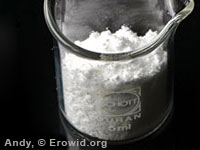Caffeine
Basics
DESCRIPTION #
Caffeine is a chemical with stimulant properties that is found in many plants including tea, coffee, and guarana. At commonly used doses it is a mild stimulant and cognitive enhancer that improves focus and mood.
Caffeine is used at dosages ranging from 5-200 mg. On average, a drip-brewed cup of coffee contains 100-150 mg caffeine, a can of cola contains 35-45 mg, and a cup of tea contains 40-60 mg.
Price #
Caffeine is widely available both in foods and beverages as well as in inexpensive capsules and tablets.
Caffeine is legal in every country around the world. In the United States, Caffeine is approved as a food additive by the Food and Drug Administration (FDA). For beverages, the FDA limits caffeine content to 72 mg per 12 ounce (355 ml) serving. Products sold as "energy drinks" are not limited by this rule because they are currently allowed as "dietary supplements" rather than food.
Caffeine is a xanthine alkaloid, with a chemical name 1,3,7-trimethylxanthine (C8H10N4O2). Its structure is very similar to the stimulants theobromine (3,7-dimethylxanthine) and theophylline (1,3-dimethylxanthine), which are frequently found in the same plants as caffeine.
Pharmacology #
When orally administered, caffeine is readily absorbed by the stomach and small intestine. It has a highly-variable elimination half-life, approximately 8-9 hours in adults. It is partially metabolized by the liver into the active dimethylxanthine stimulants theobromine and theophyline, along with other metabolites. Caffeine blockades receptors of the inhibitory neurotransmitter adenosine, and this effect is believed to be the primary mechanism of its stimulant action. Caffeine also affects GABA, the brain's primary inhibitory neurotransmitter.
Production #
Production Summary Needed.
Throughout caffeine's long history of use, which dates back into pre-history, it has been both praised and damned for its effects. Today caffeine is greeted with near-universal approval and caffeine may well be the most commonly-used psychoactive substance on the planet. Caffeine-producing plants like tea and coffee have been heavily cultivated and have played an important role in commerce throughout recorded history.
Terminology / Slang #
The Substance:
Caffeine.
The Experience:
No common terms known.
Caffeine causes stimulation, arousal, wakefulness, and increased alertness. It increases urine production (diuretic), causes blood vessels to contract (vassoconstrictor), and generally increases blood pressure.
High doses within the normal range of use (250 - 750 mg) can cause insomna, anxiety, tension, nausea, headache, and irregular heartbeat. Very high doses (750 mg - 1 g) can produce toxic symptoms such as nausea, vomiting, tremor, seizures, and irregular heart beat. There are deaths associated with caffeine overdoses, though it is extremely uncommon. The lethal dose for humans has been estimated at between 3-20 grams.
Contraindications #
- People suffering from ulcers may find that caffeine worsens these problems.
- Those with generalized anxiety disorder or panic disorder should use caution in consuming caffeine, which may trigger panic attacks in sensitive populations.
- Pregnant mothers may wish to avoid caffeine. Some studies have found a correlation between moderate caffeine intake and miscarriage while other studies have found no correlation.
Addiction Potential #
Caffeine use leads to physiological dependency and tolerance. Discontinuation of regular use causes mild to moderate withdrawal symptoms, including sluggishness, fatigue, headaches, mild depression, and sometimes restlessness.
Long Term Health Problems #
Long Term Health Problems Summary Needed.
Risk of Death #
Risk of Death Summary Needed.
CAUTION & DISCLAIMER #
Erowid Basics pages are summaries of data gathered from site visitors, government documents, books, websites, and other resources. We do our best to keep this information correct and up-to-date, but the field is complex and constantly changing. Information should always be verified through multiple sources.



